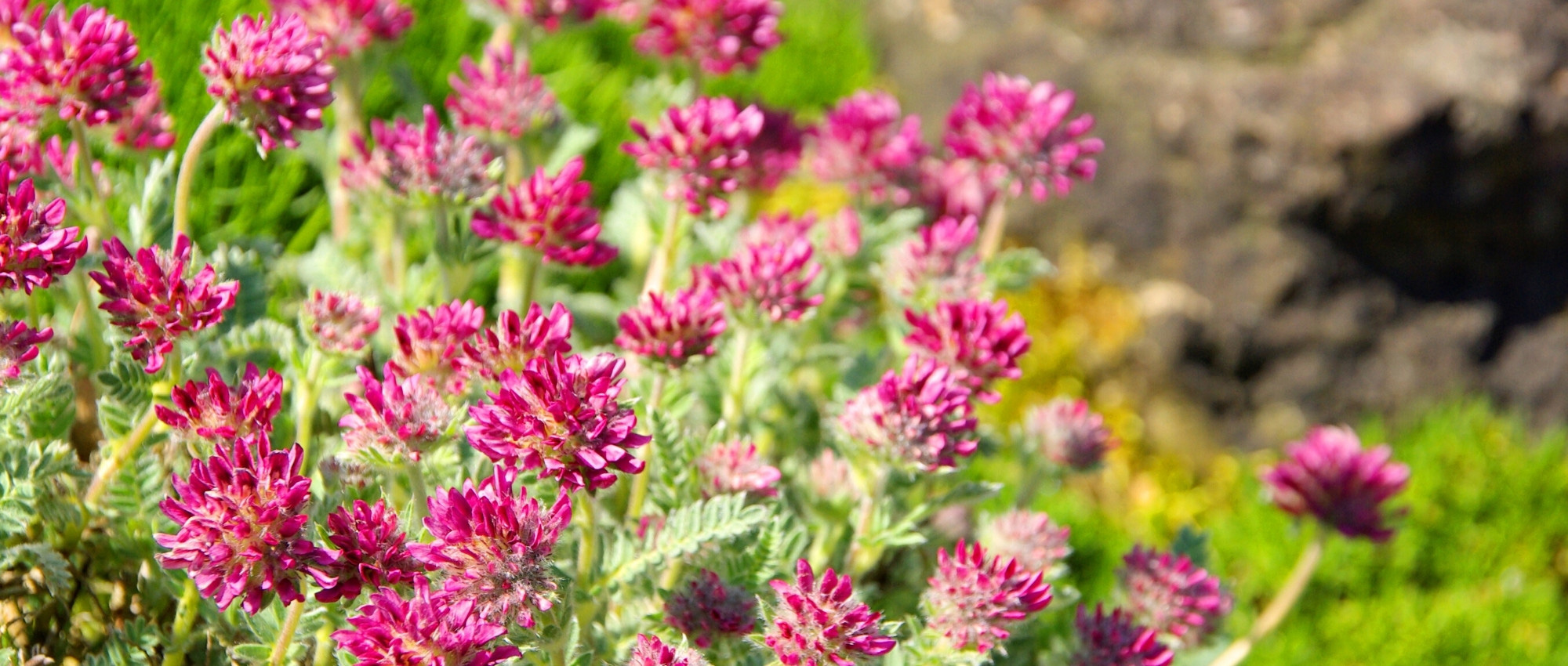
Anthyllis: planting, growing, and care
Contents
Anthyllis in a nutshell
- Anthyllis produce beautiful yellow, white, pink, or red flowers resembling clover!
- This is a highly diverse group that includes annuals, perennials, and bushes.
- Anthyllis vulneraria is renowned for its medicinal properties.
- These are perfect plants for dry, calcareous gardens.
- Anthyllis barba-jovis is a stunning bush with silver foliage, ideal for seaside gardens!
A word from our expert
Anthyllis are wild plants that can be annual, perennial, or bushy depending on the species. Most are native to southern Europe, particularly around the Mediterranean, and thrive in sunny, dry, and well-drained soils. The most well-known is the woundwort, Anthyllis vulneraria, which forms a lovely groundcover with yellow flowers and is renowned for its medicinal properties. However, there are other interesting species for the garden, including Anthyllis montana, a small spreading perennial with purple-pink flowers, and Anthyllis barba-jovis, a bush with cream-yellow flowers more suited to gardens in southern France. We also appreciate Anthyllis vulneraria var. coccinea, a variety of woundwort that offers beautiful bright red flowers.
Anthyllis thrive in full sun in perfectly drained, poor, stony, and rather calcareous soil, making them ideal for rockeries, scree gardens, or dry slopes. They are indeed sensitive to stagnant moisture. Once established, they require very little maintenance. Discover in this guide all our tips for successfully cultivating them in your garden!
Botany
Botanical data
- Latin name Anthyllis sp.
- Family Fabaceae
- Common name anthyllis, woundwort, yellow clover (A. vulneraria), Jupiter's beard (A. barba-jovis)...
- Flowering spring or summer depending on the species
- Height highly variable, between 20 cm and 1.50 m
- Exposure full sun
- Soil type well-drained, stony, rather poor and dry
- Hardiness between -10 °C and -15 °C
Anthyllis comprises 35 species of annual, perennial, or bushy plants. Several of these grow wild in France. They are plants of open environments and poor, dry soils, thriving in sunny exposures. They can be found in meadows, dry lawns, arid slopes, and rocky cliffs, primarily in the Mediterranean region. The Anthyllis montana, on the other hand, grows in mountainous regions, particularly in the Alps and Pyrenees.
Anthyllis belongs to the large family of Fabaceae (formerly Leguminosae), which includes nearly 20,000 species. This family encompasses beans, peas, clovers, lupins, as well as mimosa, albizia, and Judas tree (Cercis). This family is characterised by generally irregular and papilionaceous flowers, leaves divided into leaflets, fruits that take the form of pods, and roots with nodosities capable of fixing nitrogen.
The Anthyllis vulneraria and Anthyllis montana are quite hardy (down to -15 °C), while Anthyllis barba-jovis is a bit more sensitive: it fears temperatures below -10 °C.
The Anthyllis cytisoides, false cytisus anthyllis, is also a bush with beautiful ornamental qualities, valued for its yellow flowering and delicate foliage, resembling broom. Additionally, it is an excellent melliferous plant. In fact, it produces a monofloral honey marketed as “albaida honey.”
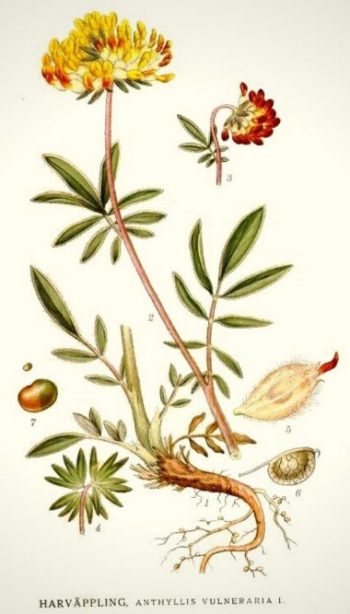
Anthyllis vulneraria: Botanical illustration
The name Anthyllis comes from the Greek anthos: “flower,” and “ioulos”: down, due to the pubescent calyx. The Anthyllis vulneraria (commonly called woundwort) derives its species name from its medicinal property: vulneraria means “that heals wounds or injuries.” Be careful not to confuse it with Hypericum nummularium, which also has this property and is commonly referred to as “woundwort”!
Thus, the woundwort anthyllis is renowned for promoting healing and treating wounds, burns, and skin inflammations, as well as for alleviating coughs. It is used in infusions for a purifying and detoxifying herbal tea, but also in decoctions or poultices. Anthyllis vulneraria is sometimes nicknamed “Alpine tea,” although this name can be confusing as it also refers to Sideritis hyssopifolia and Dryas octopetala.
As Anthyllis includes both small perennials and shrubs, their size varies greatly depending on the species. The Anthyllis vulneraria and the Anthyllis montana, for example, have a spreading, ground-covering habit, forming charming groundcovers! However, there are also shrubs, such as Anthyllis barba-jovis (Jupiter’s beard) and Anthyllis cytisoides (false cytisus anthyllis). Thus, while Anthyllis montana does not exceed 30 cm in height, Anthyllis barba-jovis can reach up to 1.50 m.
Anthyllis flowers in spring or summer depending on the different species. For instance, Anthyllis barba-jovis blooms from April to June, Anthyllis montana flowers a bit later, in late spring or early summer depending on the climate, while A. vulneraria blooms in summer between June and August.
Anthyllis plants bear small papilionaceous flowers, measuring no more than 1 to 2 cm long, resembling pea flowers but smaller. They consist of an upper petal, called the banner, two lateral petals (wings), and two ventral petals (keel) that surround the ten stamens and the pistil. The calyx is notably swollen, cream-white, and hairy (covered with a whitish down), making the flowers very distinctive and allowing easy recognition of anthyllis. Pollination is carried out by insects (entomophilous pollination).

The flowering of Anthyllis montana, A. vulneraria ‘Coccinea’ and A. barba-jovis (photos: Krzysztof Golik / Agnieszka Kwiecień / Salicyna / Henry Brisse)
The flowers of Anthyllis come in various shades: they are purplish-pink in Anthyllis montana, generally bright yellow in Anthyllis vulneraria (sometimes red or white depending on the subspecies), and very light cream yellow in A. barba-jovis.
In Anthyllis montana, Anthyllis vulneraria, and Anthyllis barba-jovis, the flowers are gathered in terminal clusters, dense and rounded, measuring between 2 and 3 cm in diameter. Their globular shape resembles that of clover inflorescences. The Anthyllis vulneraria is indeed nicknamed “yellow clover”!
The leaves of Anthyllis are finely divided and consist of numerous fine, elongated leaflets. They are odd-pinnate: there is an odd number of leaflets, with a terminal leaflet at the tip.
The Anthyllis barba-jovis has beautiful silvery, pubescent foliage, allowing it to withstand drought. Indeed, the silver hue reflects sunlight, and the hairs protect the epidermis while reducing water loss.

The finely divided foliage of Anthyllis barba-jovis, A. vulneraria, and A. montana (photos: AdobeStock / Hectonichus / Michael Wolf)
As with other Fabaceae, the roots of Anthyllis bear nodosities. These are swellings on the roots where a symbiosis occurs between bacteria and the plant, allowing atmospheric nitrogen to be fixed and made available to the Anthyllis. Thus, this plant thrives in nitrogen-poor soils and tends to enrich the soil with nitrogen. Additionally, the roots of Anthyllis vulneraria are also believed to be depolluting, capable of absorbing heavy metals present in the soil. It is the subject of studies for potential use in soil decontamination, particularly in former mining sites.
The root system of Anthyllis barba-jovis forms a taproot that allows it to anchor firmly in the soil and access water and minerals deep down.
The fruit of Anthyllis is a pod containing only one or two seeds. It opens at maturity to release them and allow the plant to reseed itself.
The main varieties of Anthyllis
The Most popular varieties
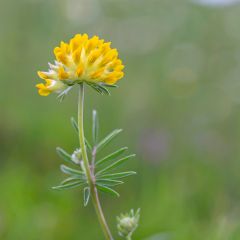
Anthyllis vulneraria
- Flowering time July to October
- Height at maturity 30 cm
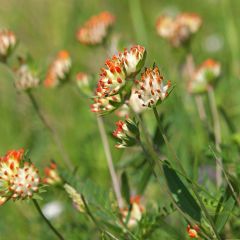
Anthyllis vulneraria var. coccinea
- Flowering time July to October
- Height at maturity 25 cm
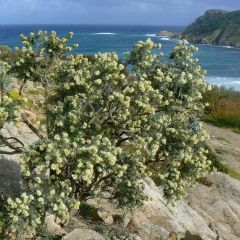
Anthyllis barba-jovis
- Flowering time May to July
- Height at maturity 1,20 m
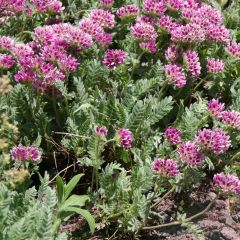
Anthyllis montana Rubra
- Flowering time July to September
- Height at maturity 15 cm
Discover other Anthyllis
View all →Available in 1 sizes

Available in 1 sizes
Available in 1 sizes
Available in 1 sizes
Planting
Where to plant?
Anthyllis is a plant that naturally grows in open environments, well-exposed to the sun. It requires warmth and will thrive in full sun. It prefers rather dry and poor, stony soils that are very well-drained, as it cannot tolerate stagnant moisture. It is perfect for rockeries. You can also place it on a dry bank, in a scree garden, or in a pot on the terrace. It also appreciates calcareous substrates.
As Anthyllis plants are sensitive to stagnant moisture, feel free to plant them on a mound or slope, in an elevated position. This will not only enhance their appearance but also allow for better drainage.
The Anthyllis barba-jovis is perfect for Mediterranean gardens, but it is also suitable for Atlantic coastal gardens. It is well adapted to seaside gardens, as it withstands sea spray and strong winds. The Anthyllis montana, on the other hand, will easily find its place in an alpine rockery, alongside other small mountain perennials.
As the perennial anthyllides are small carpeting plants, it is beneficial to plant several together (rather than a single plant), but maintain a distance of 20 to 30 cm between them. For the shrubby species (Anthyllis barba-jovis, A. cytisoides, A. hermanniae…), space them at least 80 cm apart.
If you are cultivating Anthyllis barba-jovis, choose its location carefully. As it has a deeply anchored taproot, it dislikes being transplanted.
When to plant?
Anthyllis vulneraria and Anthyllis montana are preferably planted in spring, in April-May. For Anthyllis barba-jovis, it is better to plant in early autumn in regions with a mild climate, such as the Mediterranean basin, while it is best to plant it in early spring in cooler regions.
How to plant?
- Dug a planting hole, two to three times the size of the root ball.
- Add some soil mixed with gravel or coarse sand for drainage.
- Remove the Anthyllis from its pot and plant it.
- Replace substrate all around to fill the hole, then lightly firm it down.
- Water generously.
You can apply a mineral mulch around the Anthyllis, for example with gravel, slate, or pumice. This will insulate its foliage from moisture while limiting the growth of adventive plants.
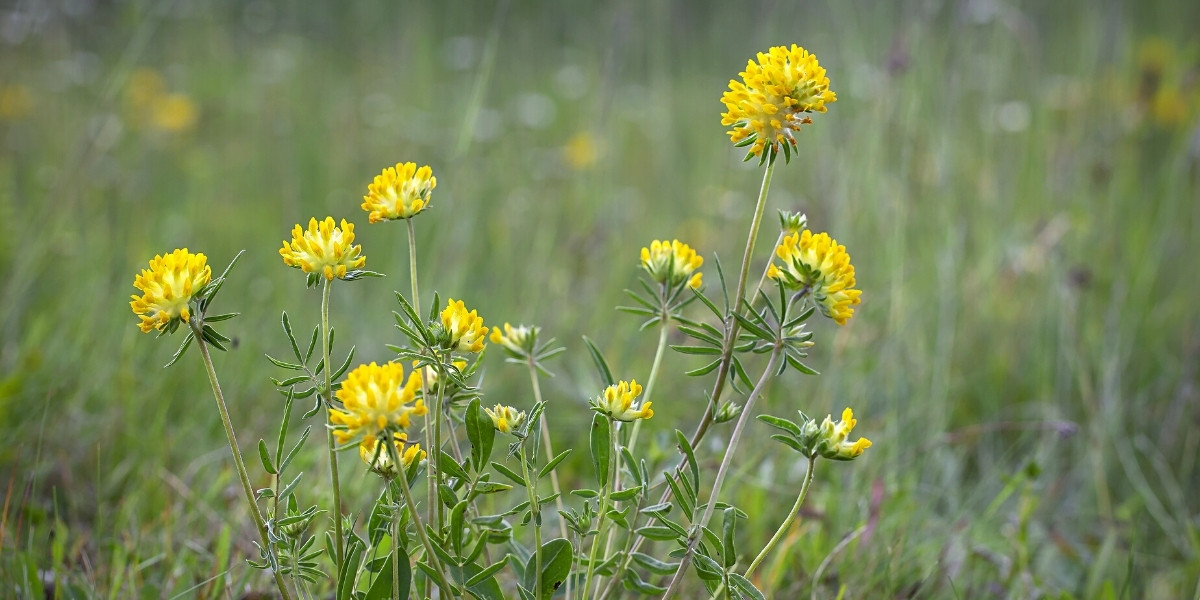
The flowering of Anthyllis vulneraria (photo Adobe Stock)
Read also
5 perennials for dry groundCare
Anthyllis are low-maintenance plants that require little care. As they grow spontaneously in poor, well-drained, stony soils, they are drought-resistant, water-efficient, and fertiliser-savvy, in addition to being quite hardy.
If you live in a rainy area, we recommend installing glass or a clear plastic sheet above the stump to protect it from rain in winter. Anthyllis are indeed sensitive to excess moisture.
The Anthyllis vulneraria is harvested in summer, when it is in flower. Fresh parts can be used as a poultice, or the plant can be dried for later use in infusions or decoctions.
You can prune the plants of Anthyllis montana and Anthyllis vulneraria once flowering has finished.
Multiplication
Anthyllis primarily propagate by sowing. It is also possible for shrubby Anthyllis to perform semi-ripe stem cuttings in summer.
Sowing
Sowing of Anthyllis takes place in autumn under a frame.
For Anthyllis vulneraria, cold stratification for three months promotes germination.
- Prepare a pot with special seed compost.
- Lightly firm and level the surface.
- Sow the seeds by scattering them on the surface.
- Cover them with a thin layer of compost, a few millimetres thick.
- Water gently.
- Place the pot in a sheltered spot, under a cold frame.
Continue to water occasionally to keep the substrate slightly moist until germination. Keep the pot sheltered for winter. In spring, you can repot the young seedlings into individual pots or plant them out in the garden.
It is also common for Anthyllis to self-seed spontaneously in the garden when they are happy there.
Associating
The Anthyllis barba-jovis will be perfect in a Mediterranean garden, alongside garrigue plants. Pair it, for example, with cistus, junipers, pistachios, strawberry trees, asphodels, spurges, Phlomis fruticosa and Armeria maritima. Also consider herbs like lavender, thyme, rosemary, hyssop… The Jupiter beard, with its fine silver foliage, beautifully complements the elegant silhouette of olive trees. Take the opportunity to play with foliage colours, for example by pairing it with other plants with grey-silver leaves: Stachys byzantina, Helichrysum, Senecio cineraria, wormwoods, Centaurea ragusina, Salvia argentea… Outside the Mediterranean basin, the Anthyllis barba-jovis will thrive by the sea along the Atlantic coast. You can create a beautiful exotic display by pairing it, for example, with agaves, prickly pears, olive trees, agapanthus, delosperma, spurges…
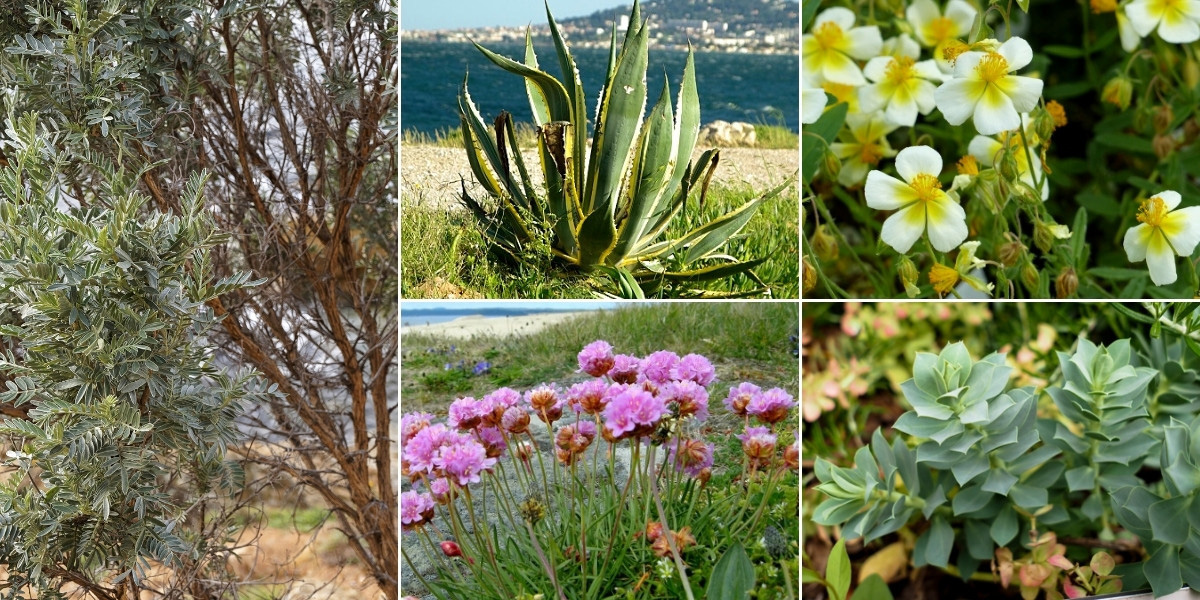
The Anthyllis barba-jovis is perfect in a Mediterranean-style seaside garden! Anthyllis barba-jovis (photo Adobe Stock), Agave americana, Helianthemum ‘Elfenbeinglanz’, Armeria maritima (photo Arnstein Rønning) and Euphorbia myrsinites
Small perennial anthyllis like Anthyllis vulneraria or Anthyllis montana will easily find their place in a gravel, mineral, and dry garden, for example with verbascums, spurges, santolines, eryngiums, Centranthus ruber, Perovskia, grasses (fescues, Stipa…)… As they require little substrate, you can also plant them on a wall or in a rockery, pairing them with helichryses, Armeria maritima, Delosperma cooperi, sedums, houseleeks, Erigeron karvinskianus… The Anthyllis montana is perfect in an alpine rockery. Don’t hesitate to pair it with other mountain plants, such as gentians, alpine lady’s mantle, Dryas octopetala, stemless carline or houseleeks.
With their carpet-like habit, small anthyllis can also simply be planted at the edge of a flowerbed, in front of taller plants. They will bring a lovely touch of colour and vitality to the front of a flowerbed! Pair them, for example, with coreopsis, helichrysum, gaura, sages, yarrow, gypsophila…
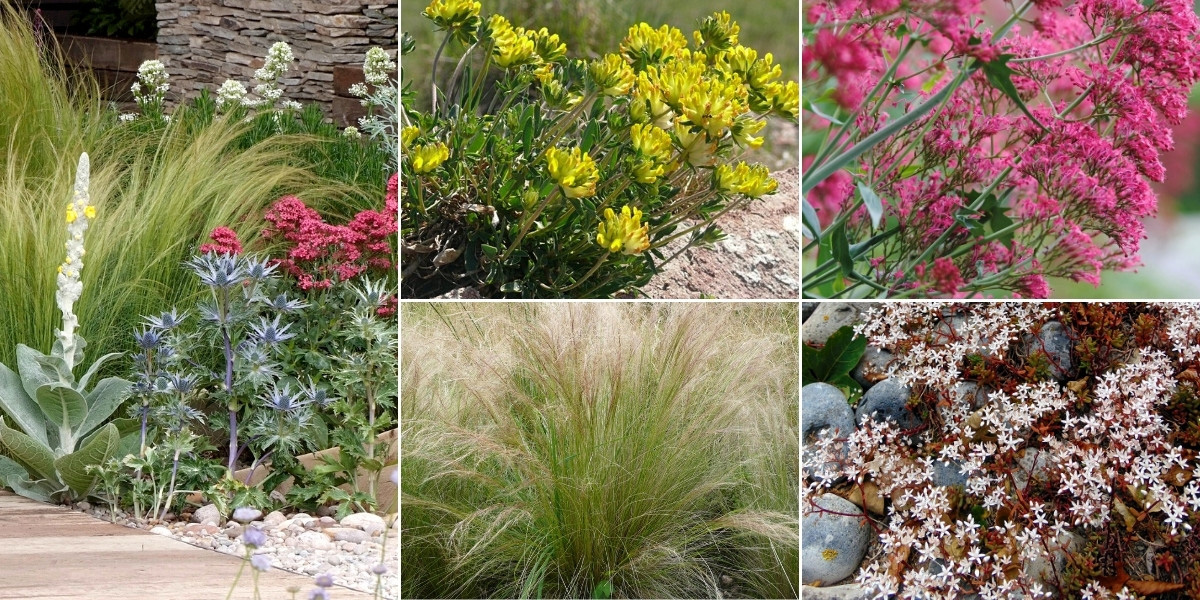
Anthyllis vulneraria and A. montana easily integrate into a dry and mineral garden. Scene with Verbascum ‘Polarsommer’, Eryngium oliverianum, Centranthus ruber and Stipa tenuifolia (photo AC – Nathalie Pasquel – MAP – landscape designer Robert Myers), Anthyllis vulneraria (photo BerndH), Centranthus ruber, Stipa tenuifolia and Sedum album
Useful resources
- Discover our range of Anthyllis
- Discover our ideas to pair Anthyllis
- To pair Anthyllis, discover our range of rock garden perennials and Mediterranean perennials
- Subscribe!
- Contents


































Comments